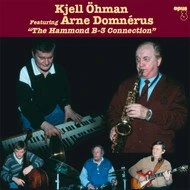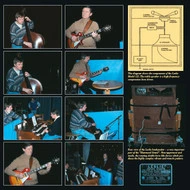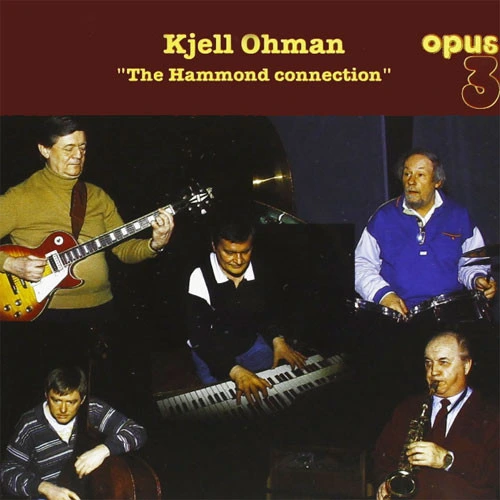High Quality 180g Vinyl LP!
From Kjell Ohman:
"When this organ album of standards came to be planned, choosing the co-performers was the best of my problems!
Arne Domnerus - This was my long-awaited opportunity of making a recording with the Nestor of Swedish jazz. In the mellow sound of his alto sax, my own Hammond B3 Organ found the perfect companion.
Rune Gustafsson - We played together a good deal in the '60s and '70s, but mostly in studios, and since then we have seen far too little of each other. Rune, to my ears, is one of the really oustanding masters of his instrument!
Leif "Gus" Dahlberg - Good timing, empathy, dexterity of the brushes and a wonderful sense of fun are just a few things to be said about "Gus". We have played together quite a lot in the past 10 years, and I want to keep it that way.
Mads Vinding - A joyful reunion! We worked together a lot, in Svend Asmussen's Quartet, for a few years in the early 1970s. Mads is one of my favorite bass players!
I hope you will have at least half of the fun we did, making this recording for a couple of days at the end of March 1994."
Re-Mastering - The original two-channel recording was made by Jan-Eric Persson of Opus 3 Records fame in March 1994 using Agfa PEM 468 tapes which had been preserved in perfect condition. This optimum condition of storage becomes of particular importance when considering the relatively subtle but important improvements necessary to achieve the aims of the LP version which had earlier only been available on ordinary CD. Using the M/S-technique etc. in an unusual way gave the possibility of making the overall sound picture clearer, plus adding a slight reverb opened up the sound picture.
The Recording - The recording was made using Opus 3's esteemed AKG C-24 valve stereo-microphone adjusted to Blumlein crossed figure of eighths capturing the total sound picture. A Neumann U-89 was used as a support for the double bass and a vintage AKG C-414 TLII on Rune's Ibanez guitar. Everything was mixed into their custom made valve mixer feeding their Telefunken M-28, 2 channel tape recorder.
The Story: The Hammond B3 organ and the Leslie Speaker - Mr. Don Leslie started to develop "The Leslie Speaker" in 1937 and it went into production in 1940. However, Mr. Laruens Hammond did not like Mr. Leslie's invention with the result that Don Leslie was obliged to start his own company, Electro Music. - But where would the Hammond Organ be without the Leslie? Mr. Hammond had designed his organ to sound like a pipe organ and this was how the Hammond Organ was developed initially, but the advent of its use together with the Leslie speaker guided its use to create a completely different kind of music to that which is normally played on a pipe organ. During the 1960s non organists discovered the Leslie and started to use it with all kinds of music to achieve the unique sounds which could be created. For example listen to Eric Clapton's Leslie processed guitar solo in the Beatles' "While My Guitar Gently Weeps" on the White Album.
When asked about why the Leslie sounds like it does, they will probably start talking about the "Doppler effect"*. "I believe that how the Leslie speaker does what it does, is pretty much misunderstood," Leslie asserts. "There have been many explanations that don't include what is really happening. The way the Leslie works, in my opinion, is that it creates motion. We have two ears, and that lets you respect motion. That's why pipe organs sound so big without overwhelming you with volume. It does not have to hurt your ears. They generate this big feeling because of the constant changing of the source, and your ears respect that. The rotating horns in the Leslie speaker simulate that. They are constantly changing position so it relieves you of that fixed, rigid-position effect. Everyone describes it as the Dopplef effect, but they really don't understand what it is doing. there's a complex situation going on with moving speakers. When the speaker moves toward you, the pitch will be going up. At the same time, there's radiation going over a wall and reflecting back to you and that sound is going down in pitch. The Leslie creates a broad sound made up of an almost infinite number of frequencies from all of these changing reflections which are bounding off the walls."
*The Doppler effect, sometimes known as the Doppler shift, is the change in frequency or wavelength of a wave in relation to an observor who is moving relative to the wave source. It is named after the Austrian physicist Christian Doppler, who described the phenomenon in 1842. A common example of Doppler shift is the change of pitch heard when a vehicle sounding a horn approaches and recedes from an observor. Compared to the emitted frequency, the frequency is higher during the approach, identical at the instant of passing by, and lower during the recession.
Recording Equipment:
Microphones: AKG C-24 Vacuum tube stereo condensor, AKG C-414 TL II and Neumann U-89
Audio Console: Opus 3 Valve Electronics by Kjell Malmberg, AV-utveckling
Monitor Speakers: Totem Acoustics, Model One and Mani-2 Signature
Features:
• High Quality 180g Vinyl LP
• Re-Mastering by Thomas Eberger at Stockholm Mastering & Jan-Eric Persson at Opus 3 Studio
• LP Cutting by Lupo at Calyx Recording in Berlin
• Gatefold jacket
• Printed in Germany
Musicians:
Kjell Ohman, Hammond B3 organ
Arne Domnerus, alto saxophone
Rune Gustafsson, guitar
Leif "Gus" Dahlberg, drums
Mads Vinding, upright bass
Selections:
Side A:
1. Summerwind
2. The Favour Of The Fool
3. 9.20 Special
4. Stardust
5. I Let A Song Go Out Of My Heart
Side B:
1. Crazy Rhythm
2. Swing House
3. Secret Love
4. Blues Opus 3
5. Stockholm Sweetnin'
From Kjell Ohman:
"When this organ album of standards came to be planned, choosing the co-performers was the best of my problems!
Arne Domnerus - This was my long-awaited opportunity of making a recording with the Nestor of Swedish jazz. In the mellow sound of his alto sax, my own Hammond B3 Organ found the perfect companion.
Rune Gustafsson - We played together a good deal in the '60s and '70s, but mostly in studios, and since then we have seen far too little of each other. Rune, to my ears, is one of the really oustanding masters of his instrument!
Leif "Gus" Dahlberg - Good timing, empathy, dexterity of the brushes and a wonderful sense of fun are just a few things to be said about "Gus". We have played together quite a lot in the past 10 years, and I want to keep it that way.
Mads Vinding - A joyful reunion! We worked together a lot, in Svend Asmussen's Quartet, for a few years in the early 1970s. Mads is one of my favorite bass players!
I hope you will have at least half of the fun we did, making this recording for a couple of days at the end of March 1994."
Re-Mastering - The original two-channel recording was made by Jan-Eric Persson of Opus 3 Records fame in March 1994 using Agfa PEM 468 tapes which had been preserved in perfect condition. This optimum condition of storage becomes of particular importance when considering the relatively subtle but important improvements necessary to achieve the aims of the LP version which had earlier only been available on ordinary CD. Using the M/S-technique etc. in an unusual way gave the possibility of making the overall sound picture clearer, plus adding a slight reverb opened up the sound picture.
The Recording - The recording was made using Opus 3's esteemed AKG C-24 valve stereo-microphone adjusted to Blumlein crossed figure of eighths capturing the total sound picture. A Neumann U-89 was used as a support for the double bass and a vintage AKG C-414 TLII on Rune's Ibanez guitar. Everything was mixed into their custom made valve mixer feeding their Telefunken M-28, 2 channel tape recorder.
The Story: The Hammond B3 organ and the Leslie Speaker - Mr. Don Leslie started to develop "The Leslie Speaker" in 1937 and it went into production in 1940. However, Mr. Laruens Hammond did not like Mr. Leslie's invention with the result that Don Leslie was obliged to start his own company, Electro Music. - But where would the Hammond Organ be without the Leslie? Mr. Hammond had designed his organ to sound like a pipe organ and this was how the Hammond Organ was developed initially, but the advent of its use together with the Leslie speaker guided its use to create a completely different kind of music to that which is normally played on a pipe organ. During the 1960s non organists discovered the Leslie and started to use it with all kinds of music to achieve the unique sounds which could be created. For example listen to Eric Clapton's Leslie processed guitar solo in the Beatles' "While My Guitar Gently Weeps" on the White Album.
When asked about why the Leslie sounds like it does, they will probably start talking about the "Doppler effect"*. "I believe that how the Leslie speaker does what it does, is pretty much misunderstood," Leslie asserts. "There have been many explanations that don't include what is really happening. The way the Leslie works, in my opinion, is that it creates motion. We have two ears, and that lets you respect motion. That's why pipe organs sound so big without overwhelming you with volume. It does not have to hurt your ears. They generate this big feeling because of the constant changing of the source, and your ears respect that. The rotating horns in the Leslie speaker simulate that. They are constantly changing position so it relieves you of that fixed, rigid-position effect. Everyone describes it as the Dopplef effect, but they really don't understand what it is doing. there's a complex situation going on with moving speakers. When the speaker moves toward you, the pitch will be going up. At the same time, there's radiation going over a wall and reflecting back to you and that sound is going down in pitch. The Leslie creates a broad sound made up of an almost infinite number of frequencies from all of these changing reflections which are bounding off the walls."
*The Doppler effect, sometimes known as the Doppler shift, is the change in frequency or wavelength of a wave in relation to an observor who is moving relative to the wave source. It is named after the Austrian physicist Christian Doppler, who described the phenomenon in 1842. A common example of Doppler shift is the change of pitch heard when a vehicle sounding a horn approaches and recedes from an observor. Compared to the emitted frequency, the frequency is higher during the approach, identical at the instant of passing by, and lower during the recession.
Recording Equipment:
Microphones: AKG C-24 Vacuum tube stereo condensor, AKG C-414 TL II and Neumann U-89
Audio Console: Opus 3 Valve Electronics by Kjell Malmberg, AV-utveckling
Monitor Speakers: Totem Acoustics, Model One and Mani-2 Signature
Features:
• High Quality 180g Vinyl LP
• Re-Mastering by Thomas Eberger at Stockholm Mastering & Jan-Eric Persson at Opus 3 Studio
• LP Cutting by Lupo at Calyx Recording in Berlin
• Gatefold jacket
• Printed in Germany
Musicians:
Kjell Ohman, Hammond B3 organ
Arne Domnerus, alto saxophone
Rune Gustafsson, guitar
Leif "Gus" Dahlberg, drums
Mads Vinding, upright bass
Selections:
Side A:
1. Summerwind
2. The Favour Of The Fool
3. 9.20 Special
4. Stardust
5. I Let A Song Go Out Of My Heart
Side B:
1. Crazy Rhythm
2. Swing House
3. Secret Love
4. Blues Opus 3
5. Stockholm Sweetnin'



 Turntable Accessories
Turntable Accessories Headphone Accessories
Headphone Accessories Cable Accessories
Cable Accessories Vinyl Accessories
Vinyl Accessories Compact Disc Accessories
Compact Disc Accessories











